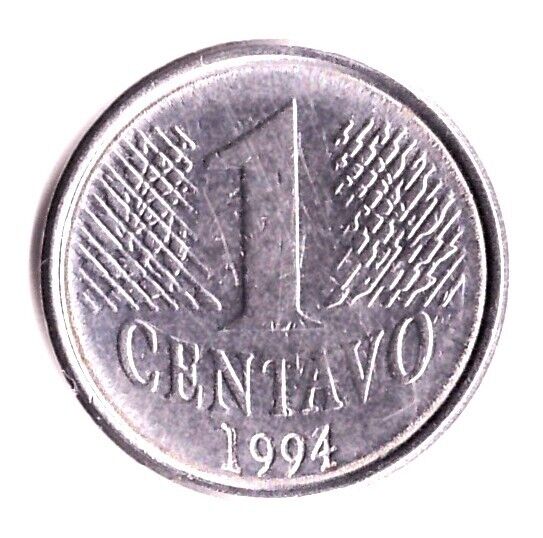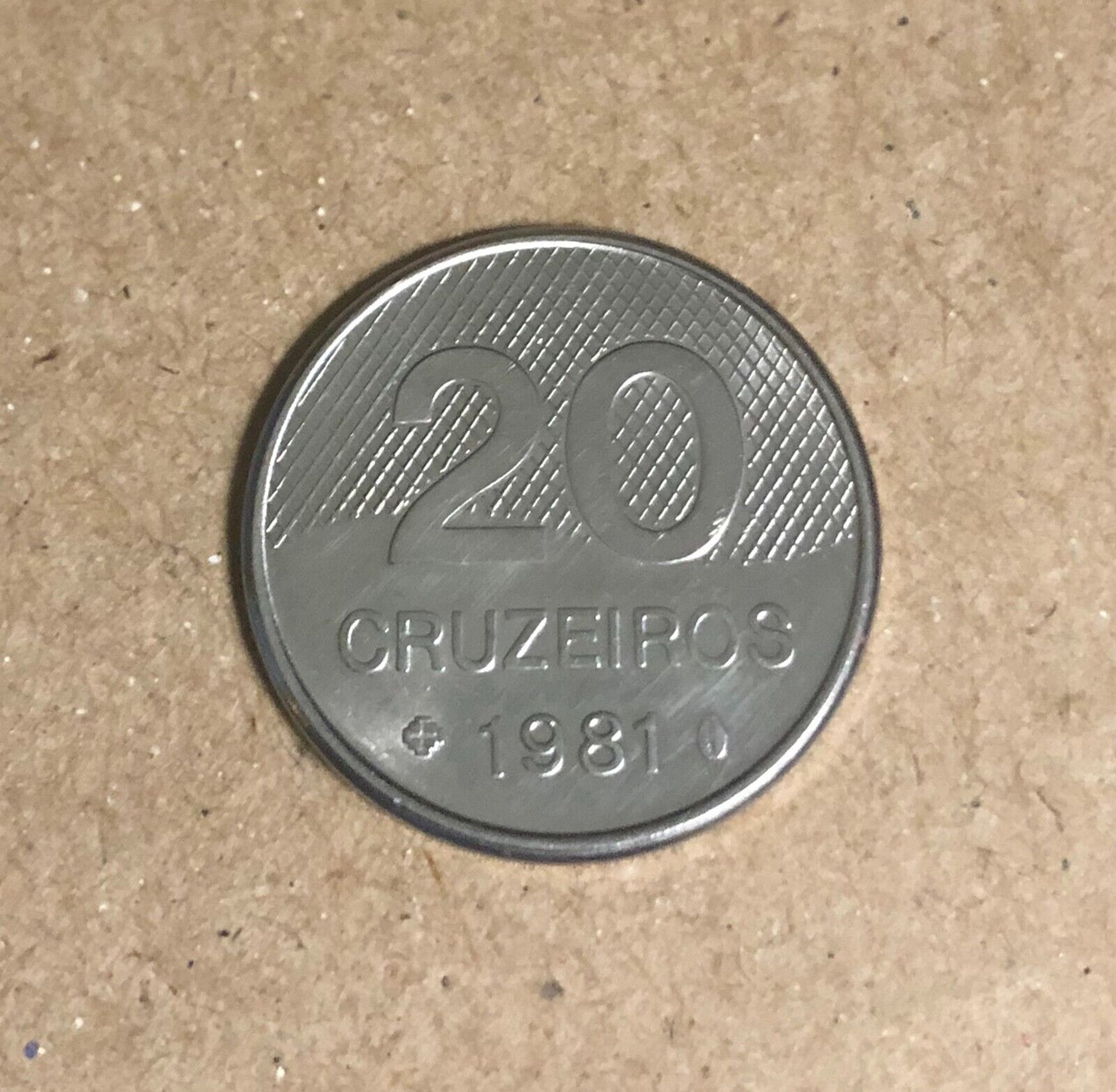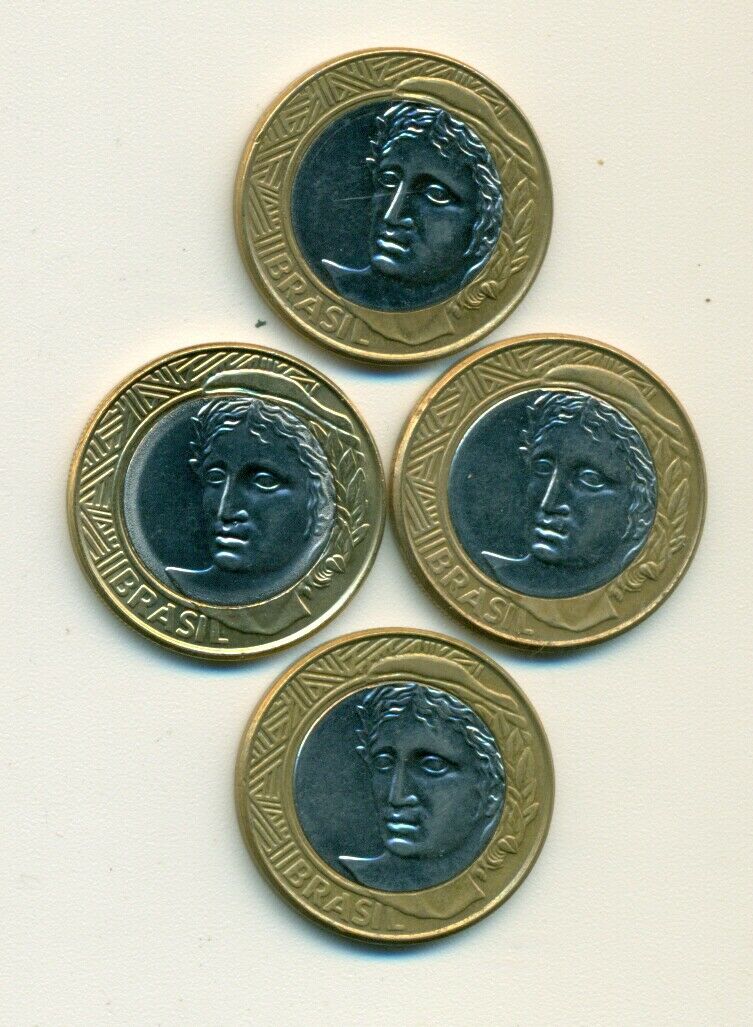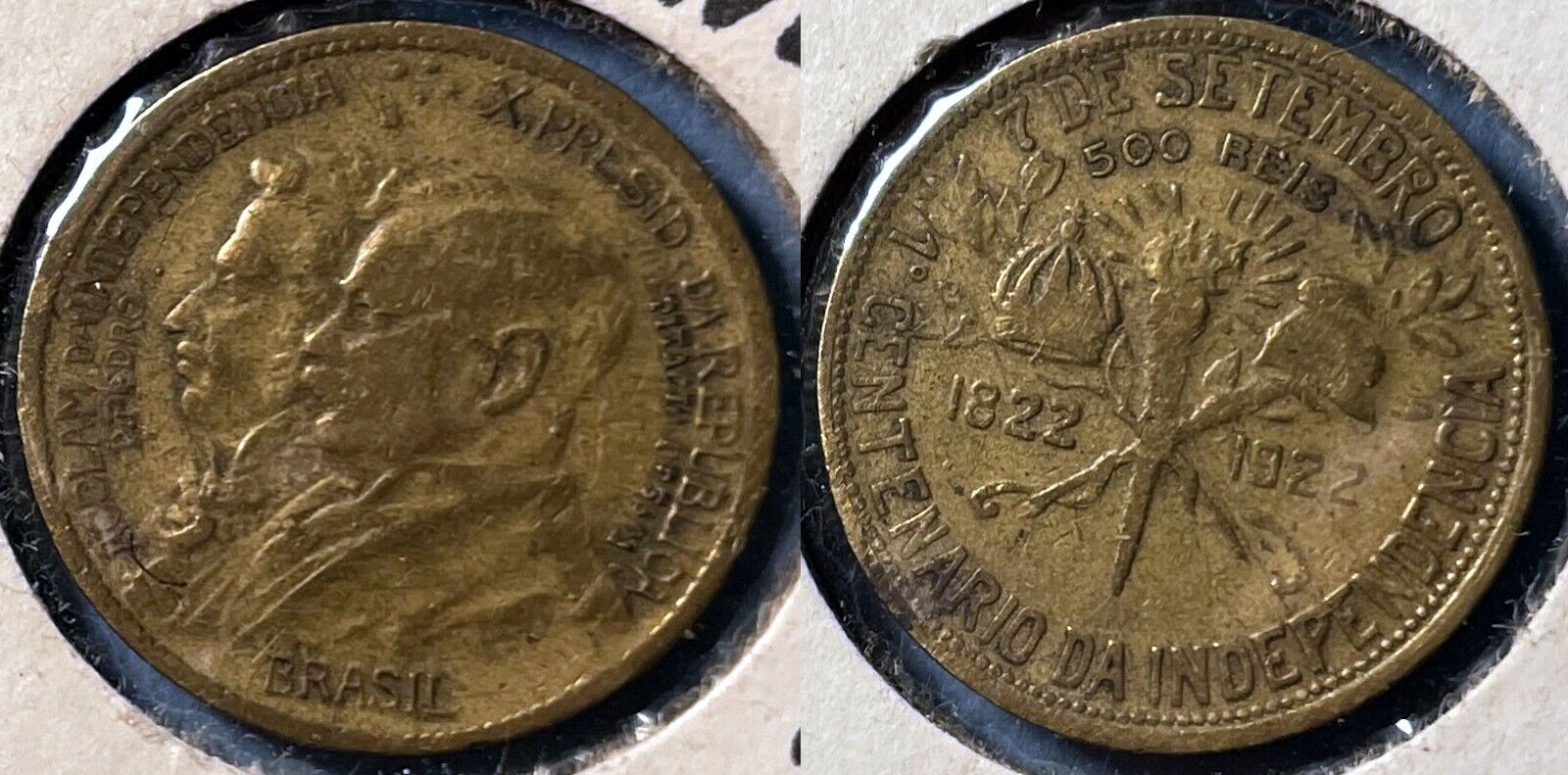-40%
1938 BRAZIL Alberto Santos Dumont AVIATION Antique Silver 5000 Reis Coin i91805
$ 110.95
- Description
- Size Guide
Description
Item:i91805
Authentic Coin of:
Brazil
- French and Brazilian Aviation Pioneer Alberto Santos Dumont (1873-1932) Commemorative
1938 Silver 5000 Reis 27mm (10.17 grams) 0.600 Silver (0.3729 oz. ASW)
Reference: KM# 543
SANTOS DUMONT CB, Portrait left of Alberto Santos-Dumont facing left.
BRASIL 5.000 ·RÉIS·WT, Wing above denomiation, year between.
You are bidding on the exact item pictured, provided with a Certificate of Authenticity and Lifetime Guarantee of Authenticity.
Alberto Santos-Dumont
(Portuguese: [awˈbɛʁtu ˈsɐ̃tuz duˈmõ]; 20 July 1873 - 23 July 1932, usually referred to as simply Santos-Dumont) was a Brazilian inventor and aviation pioneer, one of the very few people to have contributed significantly to the development of both lighter-than-air and heavier-than-air aircraft.
The heir of a wealthy family of coffee producers, Santos-Dumont dedicated himself to aeronautical study and experimentation in Paris, where he spent most of his adult life. In his early career he designed, built, and flew hot air balloons and early dirigibles, culminating in his winning the Deutsch de la Meurthe prize on 19 October 1901 for a flight that rounded the Eiffel Tower. He then turned to heavier-than-air machines, and on 23 October 1906 his 14-bis made the first powered heavier-than-air flight in Europe to be certified by the Aéro-Club de France and the Fédération Aéronautique Internationale. His conviction that aviation would usher in an era of worldwide peace and prosperity led him to freely publish his designs and forego patenting his various innovations.
Santos-Dumont is a national hero in Brazil, where it is popularly held that he preceded the Wright brothers in demonstrating a practical airplane. Countless roads, plazas, schools, monuments, and airports there are dedicated to him, and his name is inscribed on the Tancredo Neves Pantheon of the Fatherland and Freedom. He was a member of the Brazilian Academy of Letters from 1931 until his suicide in 1932.
Santos-Dumont was born on 20 July 1873 in Cabangu in the Brazilian town of Palmira (today named Santos Dumont) in the state of Minas Gerais in southeast Brazil. He was the youngest of seven children born to Henrique Dumont, an engineer of French descent, and Francisca de Paula Santos. Santos-Dumont's father managed a coffee plantation on land owned by his wife's family, and later bought land in Ribeirão Preto on which he established a plantation of his own. His extensive use of labor-saving inventions earned him a fortune, and he was known for a time as the "Coffee King of Brazil."
Santos-Dumont was fascinated by machinery, and while still a child he learned to drive the plantation's steam tractors and locomotives. He also read a great deal of the works of Jules Verne. He wrote in his autobiography that the dream of flying came to him while contemplating the magnificent skies of Brazil from the plantation.
After basic instruction with private tutors, Santos-Dumont studied for a time at the Colégio Culto à Ciência in Campinas, after which he was sent to the Colégio Morton in São Paulo and the Escola de Minas in Minas Gerais.
Move to France
In 1891 Santos-Dumont's father was partially paralyzed by a fall from a
horse. He sold the plantation and went to Europe with his wife and Santos-Dumont in search of treatment. In Paris, Santos-Dumont contacted a balloonist with the intention of making an ascent. The price quoted was 1,200 francs for a two-hour flight, plus payment for any damage caused and for returning the balloon to Paris. This was a considerable sum of money, and Santos-Dumont decided not to make the flight, reasoning that "If I risk 1,200 francs for an afternoon's pleasure I shall find it either good or bad. If it is bad the money will be lost. If it is good I shall want to repeat it and I shall not have the means." After this he bought a Peugeot automobile, which he took with him when he returned to Brazil with his parents at the end of the year.
In 1892 the family returned to Europe, but Henriques felt too ill to continue on to Paris from Lisbon, and Alberto made the journey on his own. His father's health deteriorated and he decided to return to Brazil, where he died on 30 August 1892.
For the next four years Alberto lived in Paris, studying physics, chemistry, mechanics, and electricity with the help of a private tutor, and returning to Brazil for short holidays. During this period he sold his Peugeot, replacing it with a more powerful and faster De Dion motor-tricycle. In 1896 he returned to Brazil for a longer period, but began to miss Paris and so returned to Europe in 1897. Before embarking he had bought a copy of an account of Salomon Andrée's attempt to fly to the North Pole by balloon, written by the constructors of the balloon, MM. Lachambre and Machuron. In his biography Santos-Dumont describes the book as "a revelation", and resolved to make contact with the balloon constructors when he reached Paris.
Aircraft
On arrival in Paris Santos-Dumont contacted Lachambre and Machuron and arranged to make a flight, piloted by Alexis Machuron. Taking off from Vaugirard, the flight lasted nearly two hours during which the balloon travelled 100 km (62 mi), coming down in the grounds of the Château de Ferrières. Enchanted by the experience, during the train journey back to Paris Santos-Dumont told Machuron that he wanted to have a balloon constructed for himself. Before this was completed he gained experience by making a number of demonstration flights for Lachambre.
Santos-Dumont's first balloon design, the Brésil, was remarkable for its small size and light weight, with a capacity of only 113 m3 (4,000 cu ft). In comparison, the balloon in which he had made his first flight had a capacity of 750 m3 (26,000 cu ft).
After numerous balloon flights, Santos-Dumont turned to the design of steerable balloons, or what became known as non-rigid airships, which could be propelled through the air rather than drifting along with the wind. A dirigible powered by an electric motor, La France, capable of flying at around 24 km/h (15 mph) had been successfully flown in 1884 by Charles Renard and Arthur Krebs, but their experiments had not progressed due to a lack of funding. His first design was wrecked during its second flight on 29 September 1898, and he had even less luck with his second, which was abandoned after his first attempt to fly it on 11 May 1899.
A major cause of the accidents to his first two airships had been loss of pressure causing the elongated envelope to lose shape, and for his third design he adopted a much shorter and fatter envelope shape, and towards the end of 1899 made a number of successful flights in it. Meanwhile, he had an airship shed complete with its own hydrogen generating plant constructed at the Aéro-Club de France's flying grounds in the Parc Saint Cloud.
The zenith of his lighter-than-air career came when Santos-Dumont won the Deutsch de la Meurthe prize for the first flight from the Parc Saint Cloud to the Eiffel Tower and back in less than 30 minutes, necessitating an average ground speed of at least 22 km/h (14 mph) to cover the 11 km (6.8 mi) in the allotted time.
To win the Deutsch de la Meurthe prize Santos-Dumont decided to build a bigger craft, the No. 5. On 8 August 1901, during one of his attempts, his dirigible began to lose hydrogen, and started to descend and was unable to clear the roof of the Trocadero Hotel. Santos-Dumont was left hanging in the basket from the side of the hotel. With the help of the Paris fire brigade, he climbed to the roof without injury, but the dirigible was a complete loss. He immediately ordered a replacement to be constructed, the No.6[16]
On 19 October 1901, after several more attempts, Santos-Dumont succeeded in making the return flight. Immediately after he reached Saint-Cloud, a controversy broke out regarding the precise timing of the flight: although he had reached his destination in under 30 minutes there had been a delay of over a minute before his mooring line was picked up. However a satisfactory compromise was reached, and Santos-Dumont was eventually given the prize, which he announced would be given to the poor of Paris. An additional 125,000 francs along with a gold medal was voted to him by the government of his native Brazil.
Winning the de la Meurthe prize made Santos-Dumont an international celebrity. He would float his No. 9 Baladeuse along Paris boulevards at rooftop level, sometimes landing at a cafe for lunch. Parisians affectionately dubbed Santos-Dumont le petit Santos. The fashionable people of the day copied various aspects of his style of dress, from his high collared shirts to his signature Panama hat.
In 1904 Santos-Dumont shipped his new airship No. 7 from Paris to St. Louis to fly at the Louisiana Purchase Exposition, to compete for the Grand Prize of 0,000 which was to be given to a flying machine (of any sort) that could make three round-trip flights over a 24 km (15 mile) L-shaped course at an average speed of 20 mph (32 km/h), later reduced to 15 mph (24 km/h). It was also necessary for the machine to land undamaged not more than 46 m (150 ft) from the starting point. Because he was the best-known aviator at the time, the Fair committee went to great lengths to ensure his participation, including modifying the rules. In conjunction with this trip he was invited to the White House to meet U.S. President Theodore Roosevelt.
However, upon arrival in St. Louis, Santos-Dumont found his airship's envelope to be irreparably damaged. Sabotage, although suspected, was never proven. Santos-Dumont did not participate in the contest after suspicion of the deed, a repeat of a similar incident in London, began to focus on Santos-Dumont himself. He left the Fair and returned immediately to France.
In 1904, after Santos-Dumont complained to his friend Louis Cartier about the difficulty of checking his pocket watch during flight, Cartier created his first men's wristwatch, thus allowing Santos-Dumont to check his flight performance while keeping both hands on the controls. Cartier still markets a line of Santos-Dumont watches and sunglasses.
Brazil
, officially the Federative Republic of Brazil, is the largest country in both South America and Latin America. As the world's fifth-largest country by both area and population, it is the largest country to have Portuguese as an official language-and the only one in the Americas.
Bounded by the Atlantic Ocean on the east, Brazil has a coastline of 7,491 km (4,655 mi). It borders all other South American countries except Ecuador and Chile and covers 47.3% of the continent's land area. Its Amazon River basin includes a vast tropical forest, home to diverse wildlife, a variety of ecological systems, and extensive natural resources spanning numerous protected habitats. This unique environmental heritage makes Brazil one of 17 megadiverse countries, and is the subject of significant global interest and debate regarding deforestation and environmental protection.
Brazil was inhabited by numerous tribal nations prior to the landing in 1500 of explorer Pedro Álvares Cabral, who claimed the area for the Portuguese Empire. Brazil remained a Portuguese colony until 1808, when the capital of the empire was transferred from Lisbon to Rio de Janeiro. In 1815, the colony was elevated to the rank of kingdom upon the formation of the United Kingdom of Portugal, Brazil and the Algarves. Independence was achieved in 1822 with the creation of the Empire of Brazil, a unitary state governed under a constitutional monarchy and a parliamentary system. The ratification of the first constitution in 1824 led to the formation of a bicameral legislature, now called the National Congress. The country became a presidential republic in 1889 following a military coup d'état. An authoritarian military junta came to power in 1964 and ruled until 1985, after which civilian governance resumed. Brazil's current constitution, formulated in 1988, defines it as a democratic federal republic. The federation is composed of the union of the Federal District, the 26 states, and the 5,570 municipalities.
Brazil's economy is the world's ninth-largest by nominal GDP and seventh-largest by GDP (PPP) as of 2015. A member of the BRICS group, Brazil until 2010 had one of the world's fastest growing major economies, with its economic reforms giving the country new international recognition and influence. Brazil's national development bank plays an important role for the country's economic growth. Brazil is a founding member of the United Nations, the G20, BRICS, Unasul, Mercosul, Organization of American States, Organization of Ibero-American States, CPLP, and the Latin Union. Brazil is a regional power in Latin America and a middle power in international affairs, with some analysts identifying it as an emerging global power. One of the world's major breadbaskets, Brazil has been the largest producer of coffee for the last 150 years.
Frequently Asked Questions
Mr. Ilya Zlobin
, world-renowned expert numismatist, enthusiast, author and dealer in authentic ancient Greek, ancient Roman, ancient Byzantine, world coins & more.
Who am I dealing with?
You are dealing with Ilya Zlobin, ancient coin expert, enthusiast, author and dealer with an online store having a selection of over 15,000 items with great positive feedback from verified buyers and over 10 years experience dealing with over 57,000 ancient and world coins and artifacts. Ilya Zlobin is an independent individual who has a passion for coin collecting, research and understanding the importance of the historical context and significance all coins and objects represent. Most others are only concerned with selling you, Ilya Zlobin is most interested in educating you on the subject, and providing the largest selection, most professional presentation and service for the best long-term value for collectors worldwide creating returning patrons sharing in the passion of ancient and world coin collecting for a lifetime.
How long until my order is shipped?
Orders are shipped by the next business day (after receipt of payment) most of the time.
How will I know when the order was shipped?
After your order has shipped, you will be left positive feedback, and that date could be used as a basis of estimating an arrival date. Any tracking number would be found under your 'Purchase history' tab.
USPS First Class mail takes about 3-5 business days to arrive in the U.S. International shipping times cannot be estimated as they vary from country to country.
Standard international mail to many countries
does not
include a tracking number, and can also be slow sometimes.
For a tracking number and signature confirmation, you may want to do Express Mail International Shipping, which costs more, however, is the fastest and most secure. Additionally you may be able to receive your order in as little as 3-5 business days using this method. For Express Mail International, it may be possible to place up to 10-15 items in one package (for the one shipping cost) as it is flat rate envelope, which may be the most cost-effective, secure and fastest way to receive items internationally. Send me a message about this and I can update your invoice should you want this method.
Getting your order to you, quickly and securely is a top priority and is taken seriously here.
Great care is taken in packaging and mailing every item securely and quickly.
Please be aware, I cannot take responsibility for any postal service delivery delays, especially for international packages as it may happen in rare instances.
What is a certificate of authenticity and what guarantees do you give that the item is authentic?
Each of the items sold here, is provided with a Certificate of Authenticity, and a Lifetime Guarantee of Authenticity, issued by a world-renowned numismatic and antique expert that has identified over 57,000 ancient coins and has provided them with the same guarantee. You will be very happy with what you get with the COA; a professional presentation of the coin, with all of the relevant information and a picture of the coin you saw in the listing. Additionally, the coin is inside it's own protective coin flip (holder), with a 2x2 inch description of the coin matching the individual number on the COA.
On the free-market such a presentation alone, can be considered a - value all in itself, and it comes standard with your purchases from me,
FREE.
With every purchase, you are leveraging my many years of experience to get a more complete context and understanding of the piece of history you are getting. Whether your goal is to collect or give the item as a gift, coins presented like this could be more prized and valued higher than items that were not given such care and attention to.
Buy a coin today and own a piece of history, guaranteed.
Is there a money back guarantee?
I offer a 30 day unconditional money back guarantee. I stand behind my coins and would be willing to exchange your order for either store credit towards other coins, or refund, minus shipping expenses, within 30 days from the receipt of your order. My goal is to have the returning customers for a lifetime, and I am so sure in my coins, their authenticity, numismatic value and beauty, I can offer such a guarantee.
When should I leave feedback?
Once you receive your order, please leave a positive feedback. Please don't leave any negative feedbacks, as it happens sometimes that people rush to leave feedback before letting sufficient time for their order to arrive. Also, if you sent an email, make sure to check for my reply in your messages before claiming that you didn't receive a response. The matter of fact is that any issues can be resolved, as reputation is most important to me. My goal is to provide superior products and quality of service.
How and where do I learn more about collecting ancient coins?
Visit the "
Guide on How to Use My Store
" for on an overview about using my store, with additional information and links to all other parts of my store which may include educational information on topics you are looking for.











